Abstract
Summer maize crop development, yield, and water use characteristics under water deficit conditions at different growth stages were investigated in this study using different irrigation regime treatments at the seedling (S), jointing (J), tasseling (T), and grain filling stages (F) in 2018 and 2019 in China. Ten different irrigation treatments were set, including three-irrigation application intervals (JTFi, STFi, SJFi, SJTi), two-irrigation applications (STi, JTi, JFi), and single-irrigation applications (Ti, Ji). These were compared to the control treatment (CK), which had sufficient irrigation provided at four intervals (SJTFi). The results showed that compared to CK, a water deficit at the seedling and jointing stages had a greater effect on plant height, whereas a water deficit at the tasseling and filling stages had a greater effect on the leaf area index, and a continuous water deficit had an effect on the stem diameter of summer maize. Limitations in terms of the growth and development of summer maize increased with less frequent irrigation. As irrigation decreased, the grain yield decreased, and the water use efficiency increased, and a water deficit at the tasseling stage had the greatest effect on the yield and water use efficiency. The JTFi treatment was the optimal irrigation regime with a yield decline, and its water consumption was reduced by 16.9% (p < 0.05) on average. However, compared to CK, the water use efficiency of the JTFi treatment increased by 17.3% (p < 0.05). Moreover, the JTFi treatment had the smallest maize yield response factor value (Ky) of 0.16, and its comprehensive score was the second highest after CK.
1. Introduction
Maize is one of the main crops in the world, accounting for 38% of world cereal production in 2017 [1]. China is the world’s second largest producer and consumer of maize, accounting for 22% of the total harvest area and 23% of the total global production in 2017 [1,2]. Due to the continuous growth in the population and the continuous improvement in living standards, the global demand for maize will continue to increase; therefore, China is eager to improve its grain production capacity to ensure food security [3]. Despite the continuous development of agriculture in China, the situation of agricultural water use is still grim: water resources in the North China Plain only account for 3% of the country’s total, and groundwater is the main source of agricultural water supply in this area [4,5]. Due to the imbalance between water resources and food production, North China has become the region with the most serious water shortage in China, and excessive groundwater exploitation has made the North China Plain the largest “groundwater funnel” in the world. Despite the continuous improvements in crop water use, water resources are still seriously overdrawn [4,6,7]. Therefore, maximization of the benefit of the limited water resources, ensuring the crop yield, and improving the water use efficiency, are urgent issues that need to be considered in research work.
Water deficits affect maize morphology, decreasing the plant height and leaf area [8,9]. Leaves are the main organs of photosynthesis, which is the main physiological process of crop growth and is extremely sensitive to a water deficit [10]. Water stress induces chlorophyll dysfunction and destroys photosynthetic organs, which, in turn, leads to non-stomatal limitations and a reduced photosynthetic capacity [11]. In addition, under the same water stress conditions, the decrease in photosynthesis during the tasseling stage is higher than it was during the jointing stage and grain filling stages [9,12], and decreases in photosynthesis affect the accumulation of dry matter and the formation of grain yield. Studies have shown that different degrees of water stress in maize at the V3 (three-leaf) and V7 (seven-leaf) stages leads to significant decreases in the leaf area and leaf dry weight, and it has also been determined that drought at the tasseling and filling stages leads to declines of more than 20% in the maize leaf area index [13,14]. In addition, when the drought period moves backward, the yield first decreases and then increases, and drought at the seedling stage has little effect on the yield, whereas severe drought at the tasseling stage can decrease the maize yield by 32.7% [15]. Studies have shown that drought during the jointing stage can significantly decrease the yield of maize by 33.4% [16], moderate drought at the jointing stage and tasseling stages can decrease the maize yield by 29.4% and 27.8%, respectively [17], and severe drought at the tasseling stage can reduce the maize yield by 37.6% [18]. Wang et al. [19] found that drought from the booting to the flowering stages can decrease the yield of maize by 58.7~75.4%. However, a certain degree of water deficit was beneficial to improving the water use efficiency (WUE) of the crops [20]. Studies have shown that deficit irrigation at the seedling stage of maize can effectively decrease leaf transpiration and improve WUE [21]; light deficiency at the jointing stage is beneficial to improving the WUE of maize [15], while another study showed that the WUE of maize is higher under water deficit conditions at the tasseling and filling stages [22].
Previous studies have looked at water deficit at various stages of maize growth and yield, and have defined its impact on the growth and yield of maize. However, given the current scarcity of water resources, a quantitative analysis of yield and water based on precedents should be conducted to further investigate improved irrigation strategies. Therefore, multiple irrigation regimes were set during the different growth stages of summer maize. The objectives of this study were as follows: (1) to clarify the effect of the water deficit at different growth stages on the summer maize yield during the growing season; (2) to carry out a quantitative study on the relationship between water consumption and the yield of summer maize to improve the field water management of summer maize; and (3) to thoroughly evaluate the growth and yield of summer maize under different irrigation regimes to determine the best irrigation regime for summer maize. The results of this study can provide an effective irrigation strategy for the production of maize that can ensure the stable yield of maize, and even increase its yield, while reducing irrigation and successfully saving water.
2. Materials and Methods
2.1. Site Description
Field experiments were conducted in lysimeters under a rain shelter at the Guangli Irrigation Experimental Station, Qinyang, Henan, China (35°4′40″ N, 112°56′10″ E) during the 2018–2019 growing seasons. The region has an annual average temperature of 14.5 ℃, a frost-free period of 216–240 d, 2200–2400 h of sunshine, annual average precipitation of 554 mm, and annual pan evaporation of 1775 mm. Each lysimeter was 3.33 m length × 2.0 m width × 2.0 m depth in size; the 20 cm lower portion of the lysimeter is a sand and gravel filter layer, and the bottom of the lysimeter can prevent water leakage. The soil, which is derived from alluvial sediments from the Yellow River, is classified as Aquic Ustochrept according to the USDA soil taxonomy [23]. The soil has a sandy loam texture (57.3% sand, 4.05% clay, 38.6% silt) and is a typical soil in the Huang-Huai-Hai area. The average bulk density of the 0–100 cm soil layer is 1.45 g cm−3, and the field capacity (θF) is 26% (mass basis).
2.2. Experimental Design
The experiment was arranged as a randomized block design, and different irrigation regimes were set at the seedling stage (S), jointing stage (J), tasseling stage (T), and filling stage (F) of maize. A total of 10 treatments with 3 replicates were carried out in the lysimeters (Table 1). A maize hybrid (c.v., Xianyu 335) with 110 d relative maturity was planted in early June 2018–2019, and the plant density was 60,000 plants ha−1. All of the nutrients needed to acquire a high maize yield were planted in the soil with slow-release fertilizer (equivalent to 300 kg ha−1 of pure N, 105 kg ha−1 of P2O5, and 135 kg ha−1 of K2O) during maize sowing. No topdressing was carried out during the maize growth period. After sowing, each plot was immediately irrigated with 90 mm of one of the treatments. The experimental design of the irrigation growth stages and the irrigation dates for each growth stage are shown in Table 2. With the exception of the different irrigation regimes, other cultivation practices were kept the same for all treatments.

Table 1.
Experimental design of different irrigation treatments for maize during 2018–2019.

Table 2.
Irrigation dates for the summer maize growth period in 2018–2019.
2.3. Field Measurements
2.3.1. Water Consumption and Water Use Efficiency
The water consumption (ET, mm; Equations (1) and (2)) and water use efficiency (WUE, kg m−3; Equations (3) and (4)) for summer maize were calculated as follows [20]:
where P0 is the total effective rainfall (mm), which was zero because the experiment was conducted under a rain shelter; I is the irrigation amount (mm); ΔW is the soil water depletion in a 0–100 cm soil layer during the growing stage (mm), and was positive when the soil water was refreshed and negative when consumed; R is the surface runoff, and was assumed to be zero (mm); L is the soil water side penetration (mm), and was assumed to be zero; D is the downward flux below the crop root zone (mm), and was assumed to be zero; W0 is the soil moisture at the maize sowing time (cm3 cm−3); W1 is the soil moisture when the maize was harvested (cm3 cm−3); H is the soil depth (cm); Y is the grain yield (kg ha−1); and IWUE is the irrigation water use efficiency (kg m−3).
2.3.2. Maize Yield Response Factor
The maize yield response factor (Ky) (see Equation (5)) is:
where Ya and ETa are the actual yield and water consumption for the different irrigation treatments (JTFi, STFi, etc.), respectively; Ym and ETm are the actual yield and water consumption for the control treatment (CK), respectively; and Ky is the yield response factor. In general, a larger Ky means that the crops are more sensitive to water stress during the crop growing period, and a smaller Ky means that crops have a higher tolerance to a water deficit [21].
2.3.3. Plant Height, Leaf Area Index (LAI), and Stem Diameter
When the maize reached the 4–5-leaf stage, three plants with consistent growth were selected and labeled in each plot, and the plant height, leaf length (L, cm), leaf width (W, cm), and stem diameter were measured during the grain filling stage, and the LAI for each experimental plot was calculated using Equation (6) [24]:
where LAI is the leaf area index, Lij is the leaf length (cm) of the jth leaf on the ith plant, Wij is the largest width (cm) of the jth leaf on the ith plant, m is the number plants measured, n is the number of leaves per plant, N is the number of plants in a plot, and S is the land area of a plot (cm2).
2.3.4. Leaf Photosynthesis
The photosynthetic rate of the ear leaves was measured using a Licor-6400 portable photosynthetic apparatus (LI-COR, Inc., Lincoln, NE, USA) during the grain filling stage. Photosynthetic parameters including the net photosynthetic rate (Pn), stomatal conductance (Gs), and transpiration rate (Tr) were measured from 10:00 a.m. to 11:00 a.m. on sunny days. Three plants were randomly sampled from each treatment so that the above ear leaf parameters could be measured and to take their average value.
2.3.5. Grain Yield
Before harvest, 15 ears were randomly selected from each plot to determine the ear length, bald tip length, ear diameter, row number per ear, grain number per row, grain number per ear, and the 100-grain weight. To determine the grain yield, the ears of the remaining 25 maize plants in each plot were harvested by hand and air dried for 2 weeks, the maize’s ear yield was measured, and then the grains were separated, cleaned, and weighed. Grain yield was calculated on a per hectare basis, and Equation (7) was used to calculate the maize shelling percentage.
Shelling percentage = grain yield/ear yield × 100%
2.4. Statistical Analysis
Data were analyzed using analysis of variance and principal component analysis with SPSS version 19.0 (IBM Inc., Chicago, IL, USA). Significance was declared at the probability level of 0.05 unless otherwise stated. All figures were drawn with Excel 2019 software (Microsoft, Inc., Redmond, WA, USA) and Origin 2017 (OriginLab, Inc., Northampton, MA, USA).
3. Results
3.1. Effects of Different Irrigation Treatments on Maize Growth
The results for the plant height, LAI, and stem diameter of summer maize under different irrigation treatments are shown in Figure 1. The changes in the plant height, LAI, and stem diameter under different irrigation treatments were basically the same for the two growing seasons. For the irrigation treatments that were applied in three growth stages, the plant height in the JTFi group and the LAI in the SJTi group decreased the most significantly, whereas in the SJFi group, the steam diameter decreased the most. For the irrigation treatments that were applied in two growth stages, the plant height and stem diameter decreased the most significantly in the JFi group (by approximately 12.8% and 18.4%, respectively), whereas no significant differences were determined between the two-irrigation application treatments in terms of LAI. In the single-irrigation treatments, the plant height in the Ti group was significantly lower than that of the two-irrigation application treatments, with the average decreasing by 19.9% compared to CK (p < 0.05). The LAI of Ji was significantly lower than it was in the two- and three-irrigation application treatments, with an average decrease of 30.3% being observed compared to CK (p < 0.05), whereas no significant differences were observed between the two-irrigation application treatments in terms of stem diameter. In conclusion, a water deficit at the seedling and jointing stages significantly affected the plant height in summer maize, and continuous deficit at the seedling and jointing stages had the greatest impact on the growth in summer maize, whereas a water deficit at late growth stages had a greater impact on LAI.
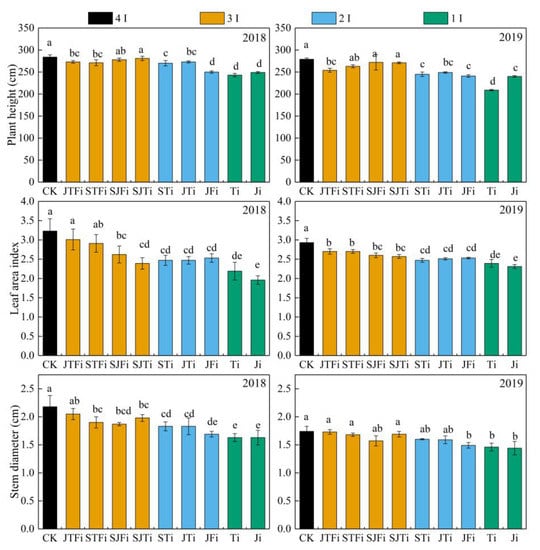
Figure 1.
Growth parameters of summer maize under different irrigation treatments. (Note: the lowercase letters indicate the differences between treatments at the 0.05 level, and “4I, 3I, 2I, and 1I” indicate the number of irrigations.).
3.2. Effects of Different Irrigation Treatments on Photosynthetic Characteristics
The Pn, Gs, and Tr of summer maize leaves decreased as the irrigation frequency decreased (Figure 2). Compared to CK, the JTFi treatment had no significant effect on the photosynthesis of summer maize leaves, whereas the Pn, Gs, and Tr of the summer maize leaves from the STFi, SJFi, and SJTi groups significantly decreased and continued to increase as the water deficit stage continued. The Pn, Gs, and Tr of the STi and JTi groups were significantly lower than those of the STFi and JTFi treatment groups, whereas the Pn and Gs of the JFi group were not significant compared to the SJFi group, and the Tr of the STi group was significantly lower than it was in the SJFi group. The Pn, Gs, and Tr of the Ti and Ji groups were significantly lower than those of the two- and three-irrigation application treatments, and the Tr of the Ji treatment group was significantly lower than that in the Ti treatment group. Obviously, a water deficit at the filling stage seriously affects photosynthesis during this stage and further affects filling.
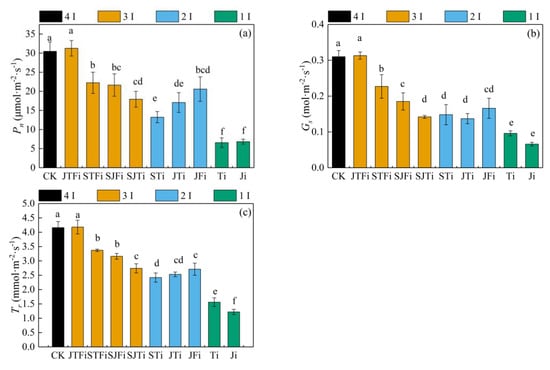
Figure 2.
Photosynthetic characteristics of summer maize under different irrigation treatments in 2018. (Note: the lowercase letters indicate the differences between treatments at the 0.05 level, and “4I, 3I, 2I, and 1I” indicate the number of irrigations. (a): net photosynthetic rate of ear leaf; (b): stomatal conductance of ear leaf; (c): transpiration rate of ear leaf).
3.3. Effects of Different Irrigation Treatments on Ear Parameters
Table 3 shows the ear length, ear diameter, bald tip length, and number of rows per ear of summer maize under different irrigation treatments. For the irrigation treatments that were applied in three growth stages, the ear length, ear diameter, and number of rows per ear decreased the most in the SJFi group. The bald tip length increased the most compared to the ear length, ear diameter, and number of rows per ear in the CK group, which decreased by 8.0%, 5.6%, and 5.5%, respectively, on average, and the bald tip length showed an average increase of 57.1%. For the irrigation treatments that were applied in two growth stages, the ear length, ear diameter, and number of rows per ear were lower in the JFi group, whereas the bald tip length was higher, but all of the parameters were lower than they were in the three-irrigation application treatments. Compared to CK, the ear length, ear diameter, and number of rows per ear decreased by 12.8%, 7.6%, and 6.8%, respectively, in the JFi group on average, and the bald tip length show an average increase of 63.3%. The single-irrigation treatments had the greatest negative effect on the ear growth in summer maize. The ear length and diameter of Ti and Ji in the single-irrigation treatments decreased significantly, and the bald tip length increased significantly in 2018 and 2019. By comparison, the ear length, ear diameter, and number of rows per ear in the Ji group were lower than they were in the T group; compared to CK, the ear length, ear diameter, and number of rows per ear decreased by 18.1%, 10.7%, and 10.0%, respectively (p < 0.05), on average, and the bald tip length showed an average increase of 168.0% (p < 0.05).

Table 3.
Ear parameters of summer maize under different irrigation treatments.
3.4. Effects of Different Irrigation Treatments on Grains Yield
The results of the maize grain yield, 100-grain weight, grains per ear, and shelling percentage are shown in Table 4. For the irrigation treatments that were applied in three growth stages, the 100-grain weight of the SJFi and SJTi groups decreased significantly; compared to the CK, an average decrease in the 100-grain weight of 7.0% and 9.2% was observed, respectively (p < 0.05), and the corresponding grain yield decreased by 15.62% and 11.1%, respectively (p < 0.05). Compared to CK, the grain yield, 100-grain weight, and grain per ear of the STi, JTi, and JFi groups was reduced significantly. In contrast, there were no significant differences observed in the 100-grain weight among the STi, JTi, and JFi groups, but the grain yield, grains per ear, and shelling percentage of the JFi group were lower than they were in the STi and JTi groups. Compared to CK, the grain yield of JFi decreased by 21.6% (p < 0.05) on average and was significantly lower than in the three-irrigation application treatments. In the single-irrigation treatments, the grain yield, 100-grain weight, grains per ear, and shelling percentage decreased significantly. By comparison, the grain yield and grains per ear of Ji were lower than those of Ti, and compared to CK, the grain yield and grains per ear of Ji decreased by 47.3% and 36.7%, respectively (p < 0.05), on average.

Table 4.
Yield and yield components of summer maize under different irrigation treatments.
3.5. Effects of Different Irrigation Treatments on Water Consumption and Water Use Efficiency
The water consumption (ET) of different irrigation treatments decreased as the irrigation frequency decreased (Figure 3). For the irrigation treatments that were applied in three growth stages, STFi and SJFi decreased the most, with the average decrease being 21.0% and 22.0%, respectively (p < 0.05). For the irrigation treatments that were applied in two growth stages, JFi was lower than the others, with the average decrease being 44.8% (p < 0.05). In the single irrigation treatments, the ET for Ji decreased by 56.0% (p < 0.05) on average.

Figure 3.
Water consumption (ET) of summer maize under different irrigation treatments. (Note: the lowercase letters indicate the differences between treatments at the 0.05 level, and “4I, 3I, 2I, and 1I” indicate the number of irrigations).
Due to the differences in the irrigation frequency among the various irrigation treatments, the daily water consumption of the different treatments at different growth stages was different (Figure 4). The daily water consumption in the JTFi, JTi, JFi, Ti, and Ji treatment groups with a water deficit at the seedling stage was lower than that of the CK treatment group in 2018 and 2019. After irrigation during the jointing stage, the daily water consumption of the JTFi, JTi, and Ji treatment groups was still lower compared to that of the CK treatment; however, the daily water consumption was higher in the JTFi, JTi, and Ji treatment groups than it was in the STFi, STi, and Ti groups under water deficit conditions at the jointing stage. The daily water consumption of the SJFi, JFi, and Ji groups with a water deficit at the tasseling stage showed an obvious decrease, and the daily water consumption of the JFi and Ji treatment groups was the smallest in 2018 and 2019, whereas the daily water consumption of the STFi, STi, and Ti treatment groups at the tasseling stage increased after irrigation to relieve the water deficit at the jointing stage. The daily water consumption during the filling stage in the SJTi, STi, Ti, and Ji treatment groups under water deficit conditions during the filling stage was lower than that in CK, but the daily water consumption in the JFi treatment group was still lower than that of the SJTi treatment group after irrigation during filling treatment.
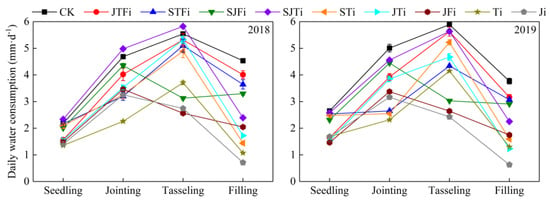
Figure 4.
Changes in daily water consumption during different growth stages of summer maize under different irrigation treatments.
Figure 5 shows the water use efficiency (WUE) and irrigation water use efficiency (IWUE) of summer maize under different irrigation treatments. For the irrigation treatments that were applied in three growth stages, the WUE and IWUE of JTFi were higher, with average increases of 17.3% and 21.7%, respectively, compared to CK (p < 0.05). By comparison, the results from the two-irrigation application treatments were higher than those from the three-irrigation application treatments: the WUE of JTi and JFi were higher than those in STi; the IWUE of JTi was higher than those in STi and JFi; and the IWUE of JTi showed an average increase of 41.8% compared to CK (p < 0.05). In the Ti single-irrigation treatments, the WUE and IWUE were higher than those in the other treatments in 2018 and 2019, with an average increase of 49.8% and 78.2% compared to CK, respectively (p < 0.05), and Ji was lower than Ti.
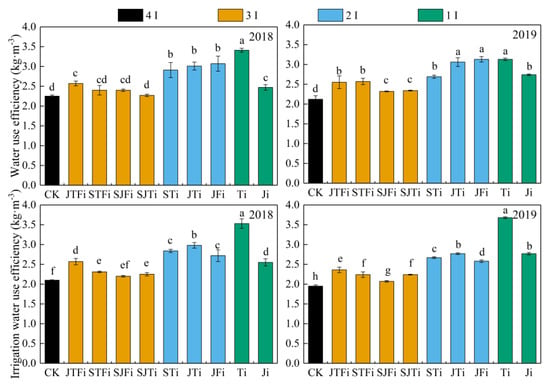
Figure 5.
Water use efficiency of summer maize under different irrigation treatments. (Note: the lowercase letters indicate the differences between treatments at the 0.05 level, and “4I, 3I, 2I, and 1I” indicate the number of irrigations).
3.6. Relationship between Grain Yield and ET
The grain yield and ET of the summer maize showed a quadratic parabola relationship (Figure 6). Through the yield and ET of the different irrigation treatments over two seasons, the water deficit and maize yield reduction were linearly fitted to obtain the corresponding Ky value of each treatment (Figure 7). The Ky values for the water deficit at different growth stages under the same irrigation frequencies were different. The Ky values in SJFi and SJTi were 0.71 and 0.69, respectively, followed by 0.45 in STFi, whereas Ky in JTFi was 0.16. It was obvious that the summer maize was the most sensitive to a water deficit during the tasseling and filling stages but had better tolerance to water deficit at the seedling stage. The Ky values in STi and JFi were 0.51 and 0.48, respectively, whereas JTi had a Ky value of 0.38. The Ky value for the Ji treatment was the largest (0.84), and the Ti treatment had a Ky value of 0.51; thus, it was proven that summer maize is more sensitive to a water deficit at the tasseling stage than at the filling stage.
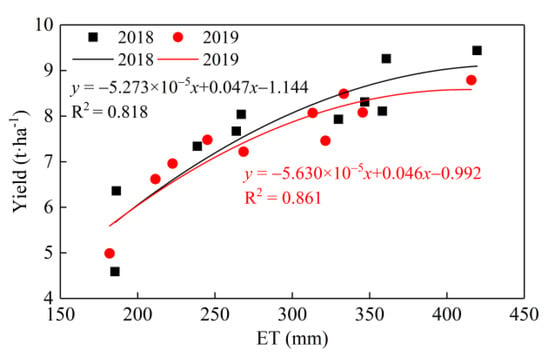
Figure 6.
Relationship between yield and water consumption of summer maize.
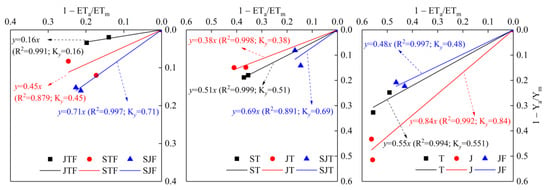
Figure 7.
Relationship between seasonal yield reduction and seasonal water deficit for maize in two growing seasons.
3.7. Principal Component Analysis
Principal component analysis (PCs) was used to extract all of the indexes, and the results are shown in Table 5. Three principal components were extracted. The eigenvalues (λ) of Principal Component 1 (PC1) was 9.38, explaining 67.0% of the total variance in the dataset; λ of PC2 was 1.85, explaining 13.2% of the total variance in the dataset; and λ of PC3 was 1.41, explaining 10.1% of the total variance in the dataset. The largest loading variable was ET, followed by grain yield, ear diameter, bald tip length, and LAI. This indicates that a water deficit in summer maize affects plant water absorption, limits plant growth, and leads to decreased grain yield (Figure 8). A comprehensive evaluation of each treatment through the two PCs was extracted by principal component analysis (Figure 9). As the irrigation frequency decreased, the comprehensive score decreased. In 2018 and 2019, the comprehensive score of the three-irrigation application treatment JTFi was the highest, whereas the score of the SJFi treatment was the lowest. The comprehensive scores of the STi and JTi in the two-irrigation application treatments were basically the same, whereas the score of the JFi treatment was the lowest, and the comprehensive score of Ti in the single-irrigation treatments was higher than that of the Ji treatment.

Table 5.
Eigenvalues and variations in the principal component analysis.
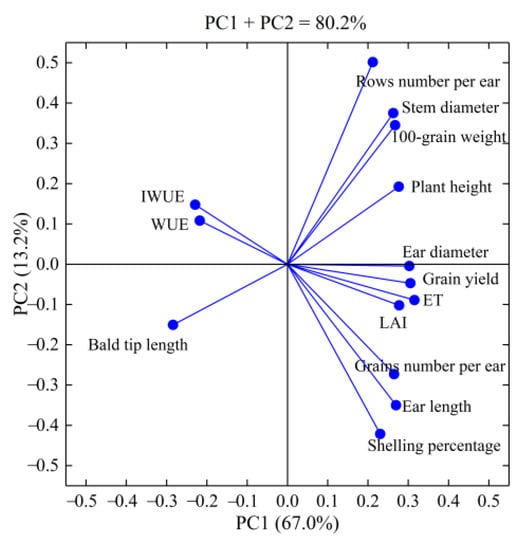
Figure 8.
Loading diagram of principal component analysis.
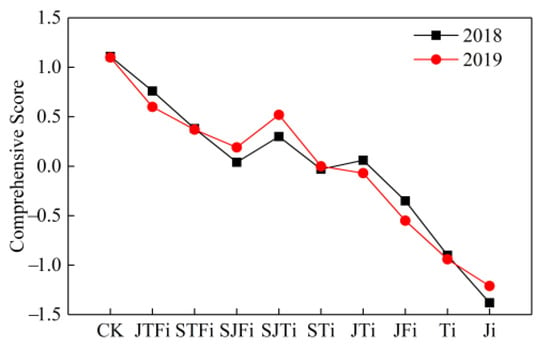
Figure 9.
Comprehensive score of all indexes in different irrigation treatments.
4. Discussion
A water deficit leads to water stress, which affects crop growth and yield formation [25]. Leaves are the main photosynthetic organs of crops and provide 50–80% of the photosynthetic products to meet grain formation needs [26]. The results showed that the leaf area of maize under water stress was significantly smaller than that under normal water conditions at the same growth stage, and the plant height and leaf area of maize were significantly increased by supplementary irrigation [14,27]. Our results showed that a water deficit at the tasseling and filling stages in the three-irrigation application treatments had a great impact on the LAI of summer maize, whereas the effect of a water deficit on LAI during the early growth stage was somewhat recovered after irrigation. The effect of a continuous water deficit at the tasseling and filling stages in the single-irrigation treatments on the LAI of summer maize was the most significant. It was obvious that a long-term water deficit at later growth stages accelerated the senescence of summer maize leaves. Ji et al. [17] found that drought at the seedling and jointing stages had a great impact on the maize leaf area, but this could be recovered to a large extent after irrigation, while drought at the silking stage and milking stages resulted in the greatest decrease in the leaf area.
Maize leaves stop growing at the silking stage and gradually age as the plant develops. However, a water deficit at the tasseling and silking stages leads to accelerated leaf senescence, decreases chlorophyll content and Pn, and results in a decrease in dry matter accumulation after silking, which ultimately leads to lower yield [26]. The response of photosynthesis to water deficit at different stages is also different, i.e., water deficit at the seedling stage inhibits stomata, causing decreased photosynthesis and water consumption and increased water use at the seedling stage [21]; however, under the same degree of water deficit in the tasseling stage, the reduction in photosynthesis is greater than it is at the jointing and milking stages [9,12]. Cai et al. [28] found that photosynthesis was more sensitive to water stress during the reproductive stage than during the vegetative stage, and that the drought resistance of leaves after the tasseling stage was poor. Our study showed that the Pn, Gs, and Tr of a water deficit at the filling stage in the three-irrigation application treatments were the lowest, followed by the tasseling stage, and Pn, Gs and Tr under water deficit conditions at the jointing and filling stages in the two-irrigation application treatments were the lowest. The Pn, Gs, and Tr of the single-irrigation treatment were significantly lower than they were in the two-irrigation application treatments, and showed the most significant decrease under continuous water deficit conditions at the tasseling and filling stages. The results of our study were similar to those of Song et al. [29], i.e., continuous water deficit severely limited the photosynthetic capacity of maize leaves, especially during the later growth stages, which may lead to a sharp decline in photosynthetic performance.
The grain yield of maize is mainly determined by yield components and is directly affected by the changes in the 100-grain weight, number of grains per ear, and other ear traits. Studies [22,27,30] have shown that under water deficit conditions, supplementary irrigation can significantly increase the number of grains per ear, 100-grain weight, ear length, and yield per unit area of maize, while at different stages, a water deficit leads to a decrease in the number of grains per ear and the 100-grain weight. Our results showed that water deficit conditions during the tasseling stage with the three-irrigation application treatments resulted in a smaller ear length and ear diameter, and a longer bald tip length. By comparison, water deficit conditions during seedling and filling stages with the two-irrigation application treatments had a smaller ear length and ear diameter, and a longer bald tip length, whereas the ear length and diameter under continuous water deficit conditions during the tasseling and filling stages in the single-irrigation treatments were significantly lower than they were for the two-irrigation application treatments, and the bald tip length increased significantly. Studies have shown that a water deficit at the tasseling stage leads to delayed pollen shedding, restricted ear growth, and increased bald tip length, which further affects the variation in the grains per ear and 100-grain weight, ultimately leading to a reduction in yield [29,31]. Under water deficit conditions, the number of grains per ear was significantly lower than that under full irrigation, and it was lower under water deficit conditions during tasseling and flowering stages, whereas the 100-grain weight was lower under water deficit conditions during grain filling stage [22,25]. Our results are consistent with those of Çakir [25] and Jin et al. [22], i.e., a water deficit at the tasseling stage in the three- and two-irrigation application treatments significantly decreased the number of grains per ear and the 100-grain weight under water deficit conditions during the filling stage. Studies have shown that the effects of water stress during the tasseling stage on the 100-grain weight and grains per ear were greater than those during the jointing stage, and it was considered that the maximum effects on grains per ear occurred during the tasseling stage and the maximum effects on the 100-grain weight occurred during filling stage [15,19,32].
The grains per ear and 100-grain weight decreased after a water deficit, which led to a decrease in the maize yield [26]. Xiao et al. [15] found that the grain yield resulting from a water deficit during seedling stage decreased the least, whereas at the tasseling stage, it decreased the most. Çakir [25] and Hirich et al. [33] found that water stress had a great effect on maize yield during the later growth stages, and the effect of water stress on the number of grains per ear and 100-grain weight was the main reason for the maize yield decline. Our study showed that under the three-irrigation application treatments, the grain yield resulting from a water deficit at the tasseling stage (SJFi) decreased the most, followed by a water deficit at the jointing (STFi) and filling stages (SJTi), and the yield resulting from a water deficit at the seedling stage (JTFi) decreased the least. Under the two-irrigation application treatments, the yield resulting from a water deficit at the tasseling stage (JFi) showed the most significant decrease, whereas the yield resulting from a continuous water deficit at the tasseling and filling stages (Ji) under a single-irrigation treatment decreased the most, which was consistent with Xiao et al. [15], Çakir [25], and Hirich et al. [33]. Çakir [25] and Song et al. [29] also found that a water deficit at the tasseling stage had a great effect on the maize yield and that a continuous water deficit had the greatest effect on maize yield.
The effects of different degrees of water deficit on the WUE of maize were also observed [20]. Attia et al. [34] found that a moderate water deficit at the vegetative growth stage can improve WUE without significantly decreasing the yield. Our results showed that the WUE and IWUE of CK were lower than those of other treatments, whereas the WUE and IWUE of the Ti treatment were larger than others; however, the Ti treatment yield decreased significantly. Compared to other water deficit treatments, the grain yield of the JTFi treatment decreased the least, but the WUE and IWUE increased significantly. Xiao et al. [15] found that the WUE in the treatment with a drought at the seedling and jointing stages was the highest, but a drought at late growth stage significantly decreased the WUE due to yield reductions. Zou et al. [21] found that a water deficit at the seedling stage can improve the WUE, and Jin et al. [22] also found that a water deficit at the vegetative growth stage can improve the WUE. Our results showed that a water deficit at the seedling stage (JTFi) resulted in a higher comprehensive score, a higher WUE value, and the smallest Ky value. Therefore, the JTFi treatment can ensure that maize has a stable yield while reducing irrigation and can successfully result in decreased water use.
5. Conclusions
In this study, different irrigation regimes were implemented to develop an optimal irrigation strategy of summer maize to improve the WUE while ensuring the maize yield. The results indicated that the maize yield showed an overall downward trend as the irrigation frequency increased, whereas the WUE showed an upward trend. In addition, summer maize had a certain tolerance to a water deficit during the early growth stage but was more sensitive to a water deficit during the late growth stages; specifically, a water deficit during the tasseling stage had the greatest effect on the maize yield and WUE. In our study, the optimal irrigation regime was the JTFi treatment, indicating that a water deficit at the seedling stage had little effect on the growth and development, physiological characteristics, and yield of summer maize. Therefore, a water deficit may be reasonable in the early stages of summer maize development, but field water management should be increased at the tasseling stage to minimize summer maize water deficits.
Author Contributions
H.C.: investigation, data curation, formal analysis, visualization, writing—original draft preparation; S.M.: conceptualization, methodology, data curation, formal analysis, writing and manuscript reviews; X.L. and C.H.: investigation; Z.L. (Zugui Liu), A.Q., B.Z. and D.N.: provided guidance and manuscript reviews; Y.G. and A.D.: methodology, writing—editing, funding acquisition. Z.L. (Zhandong Liu) conceptualization, writing—editing, supervision, project administration, funding acquisition. All authors have read and agreed to the published version of the manuscript.
Funding
This research was jointly supported by the Henan Provincial Natural Science Foundation (202300410553); the China Agriculture Research System (CARS-02-18); the Central Public-interest Scientific Institution Basal Research Fund (Farmland Irrigation Institute, CAAS, FIRI20210101); the Agricultural Science and Technology Innovation Program (ASTIP); and the Key Project of Water Conservancy Science and Technology of Henan Province (2021039) and the National Natural Science Foundation of China (32101856).
Institutional Review Board Statement
Not applicable.
Informed Consent Statement
Not applicable.
Data Availability Statement
Not applicable.
Conflicts of Interest
The authors declare no conflict of interest.
References
- Zhao, J.; Yang, X.G.; Liu, Z.J.; Pullens, J.W.M.; Chen, J.; Marek, G.W.; Chen, Y.; Lv, S.; Sun, S. Greater maize yield improvements in low/unstable yield zones through recommended nutrient and water inputs in the main cropping regions, China. Agric. Water Manag. 2020, 232, 106018. [Google Scholar] [CrossRef]
- Zhao, J.; Yang, X.G.; Sun, S. Constraints on maize yield and yield stability in the main cropping regions in China. Eur. J. Agron. 2018, 99, 106–115. [Google Scholar] [CrossRef]
- Zhang, X.Y.; Uwimpayea, F.; Yan, Z.Z.; Shao, L.W.; Chen, S.Y.; Sun, H.Y.; Liu, X. Water productivity improvement in summer maize-A case study in the North China Plain from 1980 to 2019. Agric. Water Manag. 2021, 247, 106728. [Google Scholar] [CrossRef]
- Wang, S.Q.; Hu, Y.K.; Yuan, R.Q.; Feng, W.Z.; Pan, Y.; Yang, Y.H. Ensuring water security, food security, and clean water in the North China Plain-conflicting strategies. Curr. Opin. Environ. Sustain. 2019, 40, 63–71. [Google Scholar] [CrossRef]
- Zheng, W.B.; Wang, S.Q.; Sprengerc, M.; Liu, B.X.; Cao, J.S. Response of soil water movement and groundwater recharge to extreme precipitation in a headwater catchment in the North China Plain. J. Hydrol. 2019, 576, 466–477. [Google Scholar] [CrossRef]
- Gao, Z.; Feng, H.Y.; Liang, X.G.; Lin, S.; Zhao, X.; Shen, S.; Du, X.; Cui, Y.H.; Zhou, S.L. Adjusting the sowing date of spring maize did not mitigate against heat stress in the North China Plain. Agric. For. Meteorol. 2021, 298–299, 108274. [Google Scholar] [CrossRef]
- Yin, B.Z.; Hu, Z.H.; Wang, Y.D.; Zhao, J.; Pan, Z.H.; Zhen, W.C. Effects of optimized subsoiling tillage on field water conservation and summer maize (Zea mays L.) yield in the North China Plain. Agric. Water Manag. 2021, 247, 106732. [Google Scholar] [CrossRef]
- Avramova, V.; AbdElgawad, H.; Zhang, Z.; Fotschki, B.; Casadevall, R.; Vergauwen, L.; Knapen, D.; Taleisnik, E.; Guisez, Y.; Asard, H.; et al. Drought induces distinct growth response, protection, and recovery mechanisms in the maize leaf growth zone. Plant Physiol. 2015, 169, 1382–1396. [Google Scholar] [CrossRef]
- Myers, S.S.; Smith, M.R.; Guth, S.; Golden, C.D.; Vaitla, B.; Mueller, N.D.; Dangour, A.D.; Huybers, P. Climate change and global food systems: Potential impacts on food security and undernutrition. Annu. Rev. Public Health 2017, 38, 259–277. [Google Scholar] [CrossRef]
- Chaves, M.M.; Flexas, J.; Pinheiro, C. Photosynthesis under drought and salt stress: Regulation mechanisms from whole plant to cell. Ann. Bot-Lond. 2009, 103, 551–560. [Google Scholar] [CrossRef] [Green Version]
- Efeoglu, B.; Ekmekci, Y.; Cicek, N. Physiological responses of three maize cultivars to drought stress and recovery. S. Afr. J. Bot. 2009, 75, 34–42. [Google Scholar] [CrossRef] [Green Version]
- Cai, F.; Mi, N.; Ji, R.P.; Zhao, X.L.; Shi, K.Q.; Yang, Y.; Zhang, H.; Zhang, Y.S. Effects of drought stress and subsequent rewatering on major physiological parameters of spring maize during the key growth periods. Chin. J. Appl. Ecol. 2017, 28, 3643–3652. [Google Scholar] [CrossRef]
- Zhou, H.L.; Zhou, G.S.; He, Q.J.; Zhou, L.; Ji, Y.H.; Zhou, M.G. Environmental explanation of maize specific leaf area under varying water stress regimes. Environ. Exp. Bot. 2020, 171, 103932. [Google Scholar] [CrossRef]
- Feng, R.; Zhang, Y.S.; Yu, W.Y.; Hu, W.; Wu, J.W.; Ji, R.P.; Wang, H.B. Analysis of the relationship between the spectral characteristics of maize canopy and leaf area index under drought stress. Acta. Ecol. Sin. 2013, 33, 301–307. [Google Scholar] [CrossRef]
- Xiao, J.F.; Liu, Z.D.; Liu, Z.G.; Nan, J.Q. Effects of Drought at Different Growth Stages and Different Water Availabilities on Growth and Water Consumption Characteristics of Summer Maize. J. Maize Sci. 2011, 19, 54–58, 64. [Google Scholar] [CrossRef]
- Zhang, Y.J. Effect of Earlier-Stage Drought on Yield and Quality of Maize; Northwest A&F University: Yangling, China, 2017. [Google Scholar]
- Ji, R.P.; Che, Y.S.; Zhu, Y.N.; Liang, T.; Feng, R.; Yu, W.Y.; Zhang, Y.S. Impacts of drought stress on the growth and development and grain yield of spring maize in Northeast China. Chin. J. Appl. Ecol. 2012, 23, 3021–3026. [Google Scholar] [CrossRef]
- Jiang, P.; Li, M.H.; Xue, X.P.; Li, H.Y. Effects of Drought on the Growth and Yield of Maize at Different Stage. Chin. Agric. Sci. Bull. 2013, 29, 232–235. (In Chinese) [Google Scholar]
- Wang, H.Y.; Li, Q.Z.; Zhao, H.W.; Wei, Y.X.; Pan, J.B. Effect of drought treatment at different growth stages on activity of protective enzyme and yield in spring maize. J. Northeast Agric. Univ. 2007, 38, 13–17. [Google Scholar] [CrossRef]
- Yuan, C.F.; Feng, S.Y.; Huo, Z.L.; Ji, Q.Y. Effects of deficit irrigation with saline water on soil water-salt distribution and water use efficiency of maize for seed production in arid Northwest China. Agric. Water Manag. 2019, 212, 424–432. [Google Scholar] [CrossRef]
- Zou, Y.F.; Saddiquea, Q.; Ali, A.; Xu, J.T.; Khane, M.I.; Qing, M.; Azmatf, M.; Cai, H.J.; Siddique, K.H.M. Deficit irrigation improves maize yield and water use efficiency in a semi-arid environment. Agric. Water Manag. 2021, 243, 106483. [Google Scholar] [CrossRef]
- Jin, N.; He, J.Q.; Fang, Q.X.; Chen, C.; Ren, Q.F.; He, L.; Yao, N.; Song, L.B.; Yu, Q. The Responses of Maize Yield and Water Use to Growth Stage-Based Irrigation on the Loess Plateau in China. Int. J. Plant Prod. 2020, 14, 621–633. [Google Scholar] [CrossRef]
- National Standards of China (NSC). China Soil Classification and Code (GB/T 17296-2009); NSC: Beijing, China, 2009. [Google Scholar]
- Ren, B.Z.; Zhu, Y.L.; Zhang, J.W.; Dong, S.T.; Liu, P.; Zhao, B. Effects of spraying exogenous hormone 6-benzyladenine (6-BA) after waterlogging on grain yield and growth of summer maize. Field Crop Res. 2016, 188, 96–104. [Google Scholar] [CrossRef]
- Çakir, R. Effect of water stress at different development stages on vegetative and reproductive growth of corn. Field Crop Res. 2004, 89, 1–16. [Google Scholar] [CrossRef]
- Ye, Y.X.; Wen, Z.R.; Yang, H.; Lu, W.P.; Lu, D.L. Effects of post-silking water deficit on the leaf photosynthesis and senescence of waxy maize. J. Integr. Agric. 2020, 19, 2216–2228. [Google Scholar] [CrossRef]
- Uwizeyimana, D.; Mureithi, S.M.; Karuku, G.; Kironchi, G. Effect of water conservation measures on soil moisture and maize yield under drought prone agro-ecological zones in Rwanda. Int. Soil Water Conse. 2018, 6, 214–221. [Google Scholar] [CrossRef]
- Cai, F.; Zhang, Y.S.; Mi, N.; Ming, H.Q.; Zhang, S.J.; Zhang, H.; Zhao, X.L. Maize (Zea mays L.) physiological responses to drought and rewatering, and the associations with water stress degree. Agric. Water Manag. 2020, 241, 10637. [Google Scholar] [CrossRef]
- Song, H.; Li, Y.B.; Zhou, L.; Xua, Z.Z.; Zhou, G.S. Maize leaf functional responses to drought episode and rewatering. Agric. Forest Meteorol. 2018, 249, 57–70. [Google Scholar] [CrossRef]
- Yan, S.C.; Wu, Y.; Fan, J.L.; Zhang, F.C.; Paw, U.K.T.; Zheng, J.; Qiang, S.C.; Guo, J.J.; Zou, H.Y.; Xiang, Y.Z.; et al. A sustainable strategy of managing irrigation based on water productivity and residual soil nitrate in a no-tillage maize system. J. Clean Prod. 2020, 262, 121279. [Google Scholar] [CrossRef]
- Li, W.Z.; Hao, Z.F.; Pang, J.L.; Zhang, M.; Wang, N.; Li, X.H.; Li, W.H.; Wang, L.; Xu, M.Y. Effect of water-deficit on tassel development in maize. Gene 2019, 681, 86–92. [Google Scholar] [CrossRef]
- Xu, T.J.; Lv, T.F.; Zhao, J.R.; Wang, R.H.; Chen, C.Y.; Liu, Y.E.; Zhang, L.P.; Le, C.Y.; Liu, X.Z. Response of Maize Varieties with Different Genotypes to Drought Stress at Three Critical Stages and Drought-resistant Identification. J. Agric. 2017, 7, 12–17. (In Chinese) [Google Scholar]
- Hirich, A.; Ragab, R.; Choukr-Allah, R.; Rami, A. The effect of defcit irrigation with treated wastewater on sweet corn: Experimental and modelling study using SALTMED model. Irrig. Sci. 2014, 32, 205–219. [Google Scholar] [CrossRef]
- Attia, A.; El-Hendawy, S.; Al-Suhaibani, N.; Alotaibi, M.; Tahir, M.U.; Kamal, K.Y. Evaluating deficit irrigation scheduling strategies to improve yield and water productivity of maize in arid environment using simulation. Agric. Water Manag. 2021, 249, 106812. [Google Scholar] [CrossRef]
Publisher’s Note: MDPI stays neutral with regard to jurisdictional claims in published maps and institutional affiliations. |
© 2022 by the authors. Licensee MDPI, Basel, Switzerland. This article is an open access article distributed under the terms and conditions of the Creative Commons Attribution (CC BY) license (https://creativecommons.org/licenses/by/4.0/).